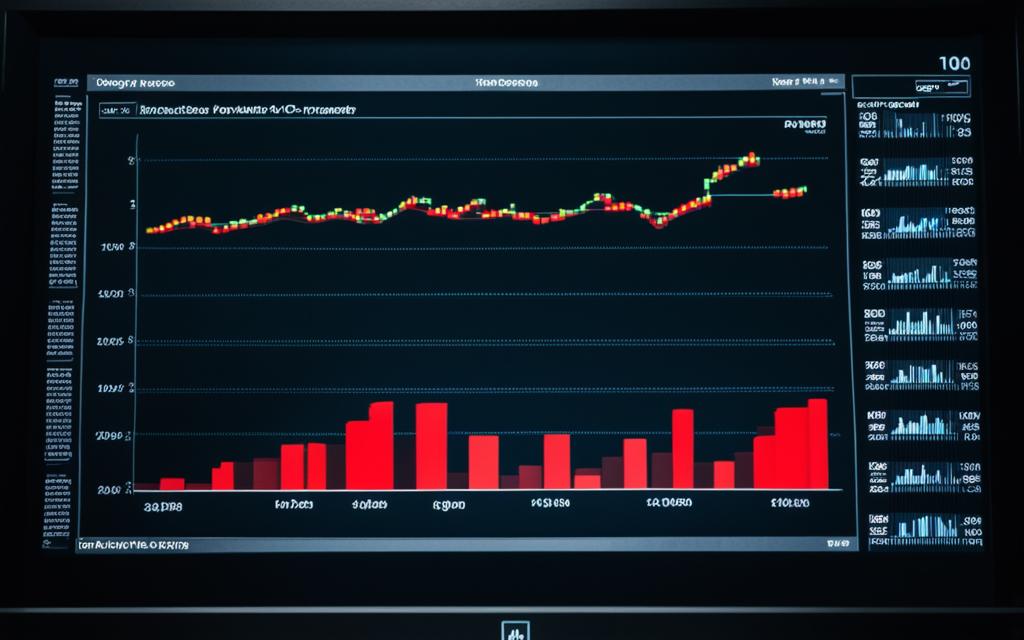Table of Contents
Seeing your CPU at 100% usage can be worrying. You might wonder if this is a sign of a serious issue. High CPU activity can slow down your computer and cause errors. This could be due to demanding programs or hidden malware.
Knowing what causes high CPU usage is the first step in solving the problem. This keeps your system running smoothly and avoids bigger troubles. For tips on handling high CPU usage, check out Intel’s advice on fixing it.
Key Takeaways
- A CPU at 100% usage may signify problems with system performance or malware presence.
- Monitoring CPU usage through system tools is essential to identify abnormal activity.
- High CPU usage can lead to significant performance issues and system crashes.
- Regular updates can inadvertently increase CPU usage due to background processes1.
- Carefully managing browser extensions can help prevent CPU spikes caused by unwanted processes1.
- Continuous monitoring of CPU activity is vital for maintaining overall system health and efficiency1.
Understanding CPU Usage
The CPU, or central processing unit, is key to any computer. It handles tasks and follows instructions that keep the computer running smoothly. Here, we will explore what a CPU is and why it’s so important for a computer’s processing power.
What is a CPU?
A CPU acts as the computer’s brain. It carries out commands from software, doing vital tasks. It’s crucial for operating programs and processing data. Knowing how the CPU works helps us understand its role in computer performance.
The Role of the CPU in Computer Performance
A CPU does more than just calculations. It affects how fast and efficiently a computer operates. It works with RAM and storage, speeding up tasks. But, when overworked, it may slow down the computer.
Trying different setups can lead to problems. For example, a 2 node cluster in various AWS zones might struggle. Here, t2 medium instances with 2 CPU cores and 4 GB memory might see high CPU use on one node because of PouchDB adjustments. Couchjs processes could overload the CPU on this node2.
It’s crucial to manage CPU loads well. Using CPUBalance and its ProBalance algorithm helps. This method improves system performance, even when editing and saving large multimedia files. It shows how managing the CPU is key to system efficiency3.
Causes of High CPU Usage
Understanding the causes of high CPU usage is crucial for keeping your system running smoothly. The main reasons for excess CPU use are demanding applications and hidden background processes. These elements are key to managing and improving computer performance.
Resource-Intensive Applications
Some software needs a lot of power to run. This includes graphic design programs, video editors, and the latest games. Using these programs at the same time, or pushing your hardware too hard, can cause CPU levels to soar. For example, a study with a 2-node CouchDB cluster showed a node’s CPU hit nearly 100% during specific tasks2. This shows how powerful apps can take over your system’s resources, causing high CPU usage.
Background Processes and Services
Even when apps are closed, many background activities still run. These consume CPU power. They include system updates and startup programs. A well-known example is the Windows Modules Installer Worker. It automatically checks and installs updates, boosting disk and CPU use each time4. You can try setting it to Manual to dodge sudden spikes in CPU use due to updates4. Understanding these background operations is essential. They significantly impact CPU usage levels.
Is It Normal for the CPU to Be at 100% Usage? (es normal que la cpu este al 100)
Getting to grips with CPU usage is crucial for keeping your system running smoothly. It’s pretty standard for the CPU to hit 100% during big tasks like setting up software or updating your system. But, if it stays high all the time, you might have a problem that needs a closer look.
Temporary Spikes vs. Continuous High Usage
Normal activities can cause short bursts of high CPU use. These spikes are normal when your computer is working hard. However, if your CPU is always at 100%, it might mean something’s wrong. This could be from apps that use lots of resources to possible hardware issues. Tools like the Task Manager in Windows [1] can show you what’s using your CPU the most. Keeping on top of maintenance can help manage these spikes.
Consequences of Prolonged High CPU Usage
Using your CPU too much can cause big problems, like making it overheat. This might harm your computer over time. Normally, CPU temperatures should be between 30°C to 40°C when it’s not doing much and might reach 60°C to 70°C when it’s working hard5. But, temperatures over 80°C are bad for your processor and can make your computer crash65. To keep things safe and stable, always check your CPU’s performance and keep your system cool.
How to Diagnose High CPU Usage
Learning how to check CPU usage is key to keeping your computer running smoothly. The task manager is vital for Windows users to do this. It shows all CPU activity monitoring in real-time, helping you find which apps use too much power.
Using Task Manager to Monitor CPU Activity
To see what’s happening, just open the task manager. Go to the ‘Processes’ tab to see all running applications. Sort them by CPU usage to easily spot the ones stressing your system. Programs like Docker, ESET Security, and Google Drive File Stream often use a lot of CPU. Keeping an eye on these can stop problems from getting worse.
Identifying Problematic Processes
Finding and controlling apps that use too much CPU is crucial for good computer performance. If you see unknown apps eating up CPU, look into them more. Use extra tools or search online to understand their impact better. Browser extensions, for example, can greatly affect CPU use. Close look at your extensions can really help in solving CPU issues efficiently1.
To really master your PC skills, including gaming PC construction, check out these custom PC building guides.
Ways to Reduce CPU Usage
Managing CPU usage well can boost a computer’s speed. You can see a big change by using simple techniques. These are the top three ways to cut down CPU use.
Closing Unnecessary Applications
Some folks forget to shut apps running in the background. Turning off apps you don’t need frees up important space. If you keep an eye on open applications, your system can work better. This allows the heavy tasks to run more smoothly.
Checking for Malware and Viruses
Regular malware checks are key for keeping your computer running well. Malware can hike up CPU usage a lot. Using trusted antivirus software to find and remove nasty programs is smart. This clears the way for your CPU to work better. Doing checks often keeps your computer safe and fast.
Updating Drivers and Software
Not updating software can cause problems, like high CPU use. Updated drivers mean your computer runs smoothly. A quick update can fix issues and boost performance. It also lessens the load on your CPU.
Preventive Measures for CPU Management
For your computer to work well and last longer, it’s important to take care of it. Regular upkeep and keeping it clean are key. They help stop it from getting too hot and ensure everything runs smoothly. We’ll now look at important maintenance tips and why it’s vital to manage power settings.
Regular Maintenance and Cleaning
Cleaning your computer, especially dust from fans and heatsinks, is important. Experts say to do this every few months to avoid dust build-up. This stops the computer from overheating7. It’s also good to check the CPU’s temperature often. This can alert you to heating issues early on, so you can act quickly7.
Another tip is to apply new thermal paste every couple of years. This paste helps with heat transfer, making your computer run better7. Also, keep your drivers, like graphics drivers, up to date. This improves how your computer performs and cools7.
Adjusting Power Settings
Managing how your computer uses power is something many people don’t think about. But, making simple changes like setting it to sleep when you’re not using it can help a lot. This reduces heat because the computer isn’t working when it doesn’t need to. Adjusting your graphics settings can also ease the load on your CPU7. These steps can fix issues like slow response times or lags when you’re doing daily tasks8.
| Maintenance Task | Recommended Frequency | Benefits |
|---|---|---|
| Cleaning Internal Components | Every few months | Prevents overheating and improves airflow |
| Updating Drivers | As needed | Enhances performance and efficiency |
| Reapplying Thermal Paste | Every few years | Improves heat transfer |
| Monitoring CPU Temperature | Regularly | Detects overheating early |
| Adjusting Power Settings | As necessary | Reduces strain and heat generation |
Conclusion
Understanding CPU usage is key to keeping computers running well. We’ve seen how different factors, like demanding apps and hidden processes, can make the CPU work harder. This is especially true for tools like accountsd and the Brave browser, which can really push the CPU910.
Using the Task Manager to spot apps that use a lot of resources is a smart move. It’s also good to keep the computer clean and tweak settings for better performance. These steps help reduce CPU load and make the computer last longer. Fixing issues quickly keeps systems running smoothly and boosts work efficiency.
Managing the CPU well means staying up-to-date with software, watching how the system performs, and dealing with CPU spikes smartly. By keeping on top of maintenance, users can avoid the stress of high CPU usage11. They’ll have a more enjoyable time using their computers without any slowdowns.
FAQ
What is a CPU?
The Central Processing Unit (CPU) is the computer’s brain. It follows software instructions, carries out vital tasks, and is crucial for computing.
What role does the CPU play in computer performance?
CPU performance directly affects how fast and efficient a computer is. It processes tasks quickly, working with RAM and storage. High usage can cause slowdowns.
What causes high CPU usage?
High usage comes from intense applications, unseen background processes, and several system services. These can all use up the CPU’s power.
Is it normal for the CPU to spike to 100% usage?
CPUs often spike to 100% temporarily during demanding tasks, like installing software or updates. But, constant high usage could signal a problem.
What are the consequences of prolonged high CPU usage?
Long-term high usage can overheating, damage hardware, shorten the computer’s life, and cause performance issues. This includes throttling and crashes.
How can I monitor CPU activity on my computer?
Windows Task Manager lets you see CPU activity live. Check the ‘Processes’ tab to spot which applications are using too much CPU.
How do I identify problematic processes consuming high CPU?
For better performance, find and check on unknown applications using a lot of resources. Use advanced tools or look online for help.
What can I do to reduce CPU usage?
Close apps you’re not using, check for malware, and update software and drivers. These steps help lower CPU usage.
How important is regular maintenance for CPU management?
Regular maintenance is key. Clean your hardware and adjust power settings to keep the CPU running well and your computer lasting longer.
Source Links
- https://support.mozilla.org/es/questions/1421058 – Firefox high CPU Usage even when no tabs open in a separate process | Foro de asistencia de Firefox
- https://groups.google.com/g/couchdb-user-archive/c/LYs-G8rR1E4 – 100% CPU on only a single node because of couchjs processes
- https://bitsum.com/portfolio/cpubalance/ – CPUBalance
- https://www.avg.com/en/signal/fix-windows-module-installer-high-cpu – How to Fix Windows Modules Installer Worker — High CPU Usage
- https://www.noyafa.com/es/blogs/base-de-conocimientos/que-es-una-buena-temperatura-de-la-cpu-una-guia-para-mantener-a-su-procesador-fresco – ¿Qué es una buena temperatura de la CPU? Una guía para mantener a su procesador fresco
- https://www.avg.com/es/signal/fix-high-cpu-usage – Cómo solucionar un uso elevado de la CPU en Windows
- https://www.linkedin.com/advice/3/what-maintenance-routines-can-you-perform-prevent-t5a4c – What maintenance routines can you perform to prevent computer overheating?
- https://www.cisco.com/c/es_mx/support/docs/routers/10000-series-routers/15095-highcpu.html – Resolución de problemas de uso elevado de la CPU en routers
- https://discussions.apple.com/thread/251846520 – Accountsd Mac cpu is high
- https://community.brave.com/t/brave-va-muy-lento-y-llena-la-ram-al-100/472340 – Brave va muy lento y llena la RAM al 100%
- https://www.chuwi.com/es/news/items/3444.html – No title found








